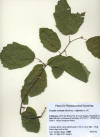|
Corylus cornuta var.
californica |
Corylus cornuta var.
californica |
|
Historical collections of Corylus cornuta for cancer research |
|
|
Ottaggio L., F. Bestoso, A. Armirotti, A. Balbi, G. Damonte, M. Mazzei, M. Sancandi and M. Miele. 2007. Taxanes from Shells and Leaves of Corylus avellana. J. Nat. Prod. Dec “Paclitaxel is an effective antineoplastic agent originally extracted in low yield from the bark of Taxus brevifolia. Although it was generally considered a particular metabolite of Taxus sp., paclitaxel was recently found in hazel cell cultures. The aim of the present work was to verify whether hazel differentiated tissues could be used as a commercial source of paclitaxel and other taxanes. Thus, shells and leaves of hazel plants were analyzed by ELISA and HPLC-MS. Both shell and leaf extracts contained taxanes. Among these, paclitaxel, 10-deacetylbaccatin III, baccatin III, paclitaxel C, and 7-epipaclitaxel were identified and quantified. Hazel extracts also showed biological activity, inhibiting metaphase to anaphase transition in a human tumor cell line. The level of total taxanes in leaves was higher than in shells collected in the same period from the same plants. However, the finding of these compounds in shells, which are considered discarded material and are mass produced by many food industries, is of interest for the future availability of paclitaxel and other antineoplastic compounds.” Wang Y., B. Guo, F. Zhang, H. Yao, Z. Miao and K. Tang. 2007. Molecular cloning and functional analysis of the gene encoding 3-hydroxy-3-methylglutaryl coenzyme A reductase from hazel (Corylus avellana L. Gasaway). J. Biochem. Mol. Biol. 40(6):861–869. “The enzyme 3-hydroxy-3-methylglutaryl-CoA reductase (HMGR; EC1.1.1.34) catalyzes the first committed step of isoprenoids biosynthesis in MVA pathway. Here we report for the first time the cloning and characterization of a full-length cDNA encoding HMGR (designated as CgHMGR, GenBank accession number EF206343) from hazel (Corylus avellana L. Gasaway), a taxol-producing plant species. The full-length cDNA of CgHMGR was 2064 bp containing a 1704-bp ORF encoding 567 amino acids. Bioinformatic analyses revealed that the deduced CgHMGR had extensive homology with other plant HMGRs and contained two transmembrane domains and a catalytic domain. The predicted 3-D model of CgHMGR had a typical spatial structure of HMGRs. Southern blot analysis indicated that CgHMGR belonged to a small gene family. Expression analysis revealed that CgHMGR expressed high in roots, and low in leaves and stems, and the expression of CgHMGR could be up-regulated by methyl jasmonate (MeJA). The functional color assay in Escherichia coli showed that CgHMGR could accelerate the biosynthesis of beta-carotene, indicating that CgHMGR encoded a functional protein. The cloning, characterization and functional analysis of CgHMGR gene will enable us to further understand the role of CgHMGR involved in taxol biosynthetic pathway in C. avellana at molecular level.”
|
|

